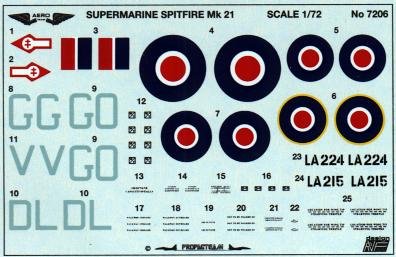
|
KIT: |
Aeroteam 1/72 Spitfire 21 |
|
KIT # |
7206 |
|
PRICE: |
10.50 Euros |
|
DECALS: |
41
Squadron, Wittering `46 |
|
REVIEW & |
|
|
NOTES: |
Short Run kit |

|
HISTORY |
(Historical segment by Scott Van Aken and taken from Aircraft of the Royal Air Force since 1918 by Owen Thetford)
The Supermarine Spitfire underwent a major redesign during 1944; the result was the F.21. You will note that with this version, the Roman numerals used to identify different variants had disappeared to be replaced by Arabic numerals, a trend still used today.
Though too late to see service during the war, it was in production during the last months of the war. Amongst the changes was the loss of the then familiar elliptical wing, a larger wing of greater strength being the replacement. In addition, the tail unit was redesigned and increased in area over previous versions. Because of the increased weight of the the aircraft, the landing gear was also strengthened. You could still tell it was a Spitfire, but none of the parts of this later, Griffon-engined version were interchangeable with the Merlin-engined Mk.I of 1938!
The Mk.21 first entered service with 91 Sq in March of 1945 and eventually were operated by nine squadrons until replaced by either Mk.22 Spits or jet powered aircraft after a very short period of service.
|
THE KIT |

The 63 kit parts are moulded in light grey plastic with wings and fuselage
having relatively fine engraved panel lines. The moulding quality is better than
most short run kits I do know, although I had an incorrect moulded underwing
radiator where a bit of the polystyrol material was missing, but that was easily
corrected with a bit filler.
Compared with drawings, the dimensions of wings and fuselage seems to be ok .
The typical Griffon engine cowling is moulded separately, like on the Fujimi
Spitfire XIV kits. All in all, the Aeroteam kit´s fuselage bears a
strong resemblance with Fujimi's XIV. Better than on the last mentioned is the
cockpit, with nice sidewall detail and instrument panel. When following the kit
instructions you should use a printed paper placard for the instruments, which
is included in the kit, too.
Two different exhausts and parts for a contra-rotating six bladed prop are
supplied with the kit, too, in all there are eleven prop-blades on the sprue of
this kit so you can use both props.
Overall fit of parts seems to be ok although the end of the lower wing was
slightly bended (see the arrow in the picture).
 A point of criticism is the
11x7 cm decal sheet from Propagteam which is nice printed, but fails to capture
the correct sky type s color for the codes. Also, the red in the roundels is a
bit too bright.
A point of criticism is the
11x7 cm decal sheet from Propagteam which is nice printed, but fails to capture
the correct sky type s color for the codes. Also, the red in the roundels is a
bit too bright.
The painting instructions do come with 4-side views on an extra sheet, and as a
nice addition they are all in 1/72. Colors are given in colors names (Ocean
grey, dark green, etc.) and FS-numbers (?-the RAF did not use the FS color
system).
With a little work and new decals this kit will be an eye catcher which isn't
seen very often on exhibitions.
The kit can be seen on my website
when it is finished.
Recommended to all Spitfire fans!
25 Sept. 2000
If you would like your product reviewed fairly and quickly by a site that has over 1,400 visits a day, please contact me or see other details in the Note to Contributors.